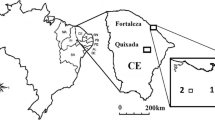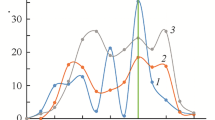Abstract
Considered is a case of the development of the cumulonimbus cloud (Cb) in the southwestern part of Saudi Arabia under the conditions of heavy pollution of atmosphere with natural aerosol. Using the ground-based radar and satellite radiometric instruments, the characteristics of the Cb are obtained for the cloud top height of more than 14 km and maximum reflectivity of 58 dBZ. To measure the precipitation rate using the radar data, the Z-I ratio obtained for the area under study was applied. To compute the precipitation rate, the results of the sounding with the SEVERI radiometer installed on the Meteosat-8 satellite were also used. Carried out are numerical experiments on the simulation of aerosol effects on the evolution of the cloud under study. The development of the cloud at the presence of background aerosol was simulated as well as at high aerosol concentration. Three cases are considered: aerosol is a passive admixture; aerosol has hygroscopic properties; aerosol has ice-forming properties. It is demonstrated that the most considerable effects on the cloud evolution are caused by the intensification of ice formation under the influence of aerosol; not only the time distribution of precipitation rate changes but also the amount of precipitation increases.
Similar content being viewed by others
References
B. A. Ashabokov, L. M. Fedchenko, V. O. Tapaskhanov, et al., Physics of Hail Clouds and Their Modification (Nalchik, 2013) [in Russian].
V. M. Voloshchuk and Yu. S. Sedunov, Coagulation Processes in Disperse Systems (Gidrometeoizdat, Leningrad, 1975) [in Russian].
Yu. A. Dovgalyuk, N. E. Veremei, and A. A. Sin’kevich, The Use of One-and-a-Half-Dimensional Model for Solving Fundamental and Applied Problems of Cloud Physics (St. Petersburg, 2007) [in Russian].
Yu. A. Dovgalyuk and L. S. Ivlev, Physics of Water and Other Atmospheric Aerosol (St. Petersburg State Univ., St. Petersburg, 1998) [in Russian].
Yu. A. Dovgalyuk, A. A. Sin’kevich, V. D. Stepanenko, et al., “The Use of Numerical Model of Convective Cloud for Assessing Aerosol Pollution of Underlying Surface at the Accident at NPP,” in Problems of the Atmospheric Boundary Layer Physics and Air Pollution (to the 80th Birthday of Professor M. E. Berlyand) (Gidrometeoizdat, St. Petersburg, 2002) [in Russian].
V. E. Zuev and M. V. Kabanov, Atmospheric Aerosol Optics (Gidrometeoizdat, Leningrad, 1987) [in Russian].
V. E. Zuev and G. M. Krekov, Optical Models of Atmosphere (Gidrometeoizdat, Leningrad, 1986) [in Russian].
L. S. Ivlev, Chemical Composition and Structure of Atmospheric Aerosols (Leningrad State Univ., Leningrad, 1982) [in Russian].
K. Ya. Kondrat’ev and D. V. Pozdnyakov, Aerosol Models of Atmosphere (Nauka, Moscow, 1981) [in Russian].
T. W. Krauss, A. A. Sin’kevich, R. Burger, et al., “Investigation of the Impact of Dynamic Factors on Cb Cloud Development in Saudi Arabia,” Meteorol. Gidrol., No. 10 (2011) [Russ. Meteorol. Hydrol., No. 10, 36 (2011)].
T. W. Krauss, A. A. Sin’kevich, and A. S. Ghulam, “High-intensity Precipitation Measurement Using Remote Methods,” Meteorol. Gidrol., No. 7 (2012) [Russ. Meteorol. Hydrol., No. 7, 37 (2012)].
O. P. Petrenchuk, Experimental Studies of Atmospheric Aerosol (Gidrometeoizdat, Leningrad, 1979) [in Russian].
Yu. F. Ponomarev and A. A. Sin’kevich, “Electrification of Convective Clouds over Northwestern Russia,” Meteorol. Gidrol., No. 6 (1997) [Russ. Meteorol. Hydrol., No. 6 (1997)].
E. L. Potashnik and A. D. Kuznetsov, Mathematical Modeling of Cloud Processes. Teaching Aid (Russ. State Hydrometeorol. Univ., St. Petersburg, 2010) [in Russian].
A. A. Sin’kevich, Convective Clouds of Northwestern Russia (Gidrometeoizdat, Leningrad, 2001) [in Russian].
A. A. Sin’kevich and T. W. Krauss, “Cloud Modification in Saudi Arabia: Statistical Estimation of the Results,” Meteorol. Gidrol., No. 6 (2010) [Russ. Meteorol. Hydrol., No. 6, 35 (2010)].
N. S. Shishkin, Clouds, Precipitation, and Thunderstorm Electricity (Gidrometeoizdat, Leningrad, 1964) [in Russian].
S. M. Shmeter, Thermodynamics and Physics of Convective Clouds (Gidrometeoizdat, Leningrad, 1987) [in Russian].
A. S. Ackerman, O. B. Toon, J. P. J. Taylor, et al., “Effects of Aerosols on Cloud Albedo: Evaluation of Twomey’s Parameterization of Cloud Susceptibility Using Measurements of Ship Tracks,” J. Atmos. Sci., 57 (2000).
M. A. Addullah and M. A. Al-Mazroui, “Climatological Study of the Southwestern Region of Saudi Arabia. I. Rainfall Analysis,” Climate Res., 9 (1998).
M. O. Andreae, D. Rosenfeld, P. Artaxo, et al., “Smoking Rain Clouds over the Amazon,” Science, 303 (2004).
T. L. Bell, D. Rosenfeld, K. Kim, et al., “Midweek Increase in U.S. Summer Rain and Storm Heights Suggests Air Pollution Invigorates Rainstorms,” J. Geophys. Res., 113 (2008).
E. X. Berry, “Cloud Droplet Growth by Collection,” J. Atmos. Sci., 24 (1967).
R. D. Borys, D. H. Lowenthal, S. A. Cohn, and W. O. J. Brown, “Mountaintop and Radar Measurements of Anthropogenic Aerosol Effects on Snow Growth and Snow Rate,” Geophys. Res. Lett., No. 10, 30 (2003).
R. D. Borys, D. H. Lowenthal, and D. L. Mitchel, “The Relationship among Cloud Physics, Chemistry and Precipitation Rate in Cold Mountain Clouds,” Atmos. Environ., 34 (2000).
S. A. Changnon, Jr., “More on the LaPorte Anomaly: A Review,” Bull. Amer. Meteorol. Soc., 61 (1980).
P. Y. Chuang, D. R. Collins, H. Pawlowska, et al., “CCN Measurements During ACE-2 and Their Relationship to Cloud Microphysical Properties,” Tellus, 52B (2000).
U. Dayan, B. Ziv, T. Shoob, and Y. Enzel, “Suspended Dust over Southeastern Mediterranean and Its Relation to Atmospheric Circulations,” Int. J. Climatol., 28 (2008).
P. J. DeMott, K. Sassen, M. R. Poellet, et al., “African Dust Aerosols as Atmospheric Ice Nuclei,” Geophys. Res. Lett., No. 14, 30 (2003).
M. Dixon and G. Wiener, “TITAN: Thunderstorm Identification, Tracking, Analysis, and Nowcasting—A Radar-based Methodology,” J. Atmos. Oceanic Technol., No. 6, 10 (1993).
A. S. Ghulam, The Development of a Heavy Thunderstorm Climatology in Saudi Arabia Based on Observations, Analyses and Numerical Simulations, PhD Thesis (Univ. of East Anglia, Norwich, England, 2007).
I. Gultepe, G. A. Isaac, W. R. Leaitch, and C. M. Banic, “Parameterizations of Marine Stratus Microphysics Based on In Situ Observations: Implications for GCMs,” J. Climate, 9 (1996).
T. Heinemann, MPE Validation Status Report, Technical Report (OPS/TH) (EUMETSAT, 2003).
C. Hoose and O. Mohler, “Heterogeneous Ice Nucleation on Atmospheric Aerosols: A Review of Results from Laboratory Experiments,” Atmos. Chem. Phys. Discuss., No. 467, 12 (2012).
D. B. Johnson, “The Role of Giant and Ultra-giant Aerosol Particles in Warm Rain Initiation,” J. Atmos. Sci., 39 (1982).
E. Kessler, “On the Distribution and Continuity of Water Substance in Atmospheric Circulations,” Meteorological Monographs, No. 32, 10 (1969).
T. W. Krauss, A. A. Sinkevich, and A. S. Ghulam, “Effects of Feeder Cloud Merging on Storm Development in Saudi Arabia,” JKAU: Met., Env. & Arid Land Agric. Sci., No. 2, 22 (2011).
T. W. Krauss, A. A. Sinkevich, and A. S. Ghulam, “Precipitation Characteristics of Natural and Seeded Cumulus Clouds in the Asir Region of Saudi Arabia,” J. Wea. Modification, 42 (2010).
A. Khain, A. Pokrovsky, M. Pinsky, et al., “Simulation of Effects of Atmospheric Aerosols on Deep Turbulent Convective Clouds Using a Spectral Microphysics Mixed Phase Cumulus Cloud Model. Part I: Model Description and Possible Applications,” J. Atmos. Sci., 61 (2004).
P. A. Kucera, D. Axisa, R. P. Burger, et al., “Features of the Weather Modification Assessment Project in the Southwest Region of Saudi Arabia,” J. Wea. Modification, 42 (2010).
W. R. Leaitch, G. A. Isaac, J. W. Strapp, et al., “The Relationship between Cloud Droplet Number Concentrations and Anthropogenic Pollution: Observations and Climatic Implications,” J. Geophys. Res., 97 (1992).
Z. Levin and W. R. Cotton, Aerosol Pollution Impact of Precipitation: A Scientific Review (Springer Verlag. 2009).
Y. Liu and P. H. Daum, “Parameterization of the Autoconversion Process, Part I: Analytical Formlation of the Kessler-type Parameterizations,” J. Atmos. Sci., 61 (2004).
Y. Liu, P. H. Daum, and R. L. McGraw, “Parameterization of the Autoconversion Process: Kessler-type, Sundqvist-type, and Unification,” in Proceedings of the 15th ARM Science Team Meeting, Daytona Beach, Florida, March 14–18, 2005.
G. K. Mather, M. J. Dixon, and J. M. DeJager, “Assessing the Potential for Rain Augmentation—The Nelspruit Randomized Convective Cloud Seeding Experiment,” J. Appl. Meteorol., 35 (1996).
S. D. Pawar, D. M. Lal, and P. Murugavel, “Lightning Characteristics over Central India during Indian Summer Monsoon,” J. Atmos. Res., 106 (2011).
H. R. Pruppacher and J. D. Klett, Microphysics of Clouds and Precipitations (D. Reidel Publishing Company. 1978).
L. F. Radke, J. A. Coakley, Jr., and M. D. King, “Direct and Remote Sensing Observations of the Effects of Ships on Clouds,” Science, 246 (1989).
V. Ramanathan et al., “The Indian Ocean Experiment: An Integrated Assessment of the Climate Forcing and Effects of the Great Indo-Asian Haze,” J. Geophys. Res., No. 28, 106 (2001).
D. Rosenfeld, “TRMM Observed First Direct Evidence of Smoke from Forest Fires Inhibiting Rainfall,” Geophys. Res. Lett, No. 20, 26 (1999).
D. Rosenfeld and A. Givati, “Evidence of Orographic Precipitation Suppression by Air Polllution Induced Aerosols in the Western USA,” J. Appl. Meteorol., 45 (2006).
D. Rosenfeld and W. L. Woodley, “Pollution and Clouds,” Physics World, 14 (2001).
P. Seifert, A. Ansmann, I. Mattis, et al., “Saharan Dust and Heterogeneous Ice Formation: Eleven Years of Cloud Observations at a Central European EARLINET Site,” J. Geophys. Res., 115 (2010).
A. Seifert and K. Beheng, “A Two-moment Cloud Microphysics Parameterization for Mixed-phase Clouds. Part II: Maritime versus Continental Deep Convective Storms,” Meteorol. Atmos. Phys., 92 (2006).
A. Seifert and B. Stevens, “Microphysical Scaling Relations in a Kinematic Model of Isolated Shallow Cumulus Clouds,” J. Atmos. Sci., 67 (2010).
J. P. Taylor and A. McHaffie, “Measurements of Cloud Susceptibility,” J. Atmos. Sci., 51 (1994).
D. Trochkine, Y. Iwasaka, A. Matsuki, et al., “Mineral Aerosol Particles Collected in Dunhuang, China, and Their Comparison with Chemically Modified Particles Collected over Japan,” J. Geophys. Res., 108 (2003).
G. Vali, Aircraft Studies in the Asir, Report No. AS163 (Univ. of Wyoming, Dept. of Atmos. Sci., 1991).
J. Warner, “A Reduction in Rainfall Associated with Smoke from Sugar-cane Fires: An Inadvertent Weather Modification,” J. Appl. Meteorol., 7 (1968).
J. Warner and S. Twomey, “The Production of Cloud Nuclei by Cane Fires and the Effect on Cloud Droplet Concentration,” J. Atmos. Sci., 24 (1967).
Author information
Authors and Affiliations
Corresponding author
Additional information
Original Russian Text © A.A. Sinkevich, T. W. Krauss, S.D. Pavar, N.E. Veremei, Yu.A. Dovgalyuk, A.B. Kurov, V. Gopalakrishnan, 2014, published in Meteorologiya i Gidrologiya, 2014, No. 9, pp. 16–33.
About this article
Cite this article
Sinkevich, A.A., Krauss, T.W., Pavar, S.D. et al. Investigation of the effects of high atmospheric aerosol pollution on the development of the high-depth cumulonimbus cloud. Russ. Meteorol. Hydrol. 39, 577–589 (2014). https://doi.org/10.3103/S1068373914090027
Received:
Published:
Issue Date:
DOI: https://doi.org/10.3103/S1068373914090027




